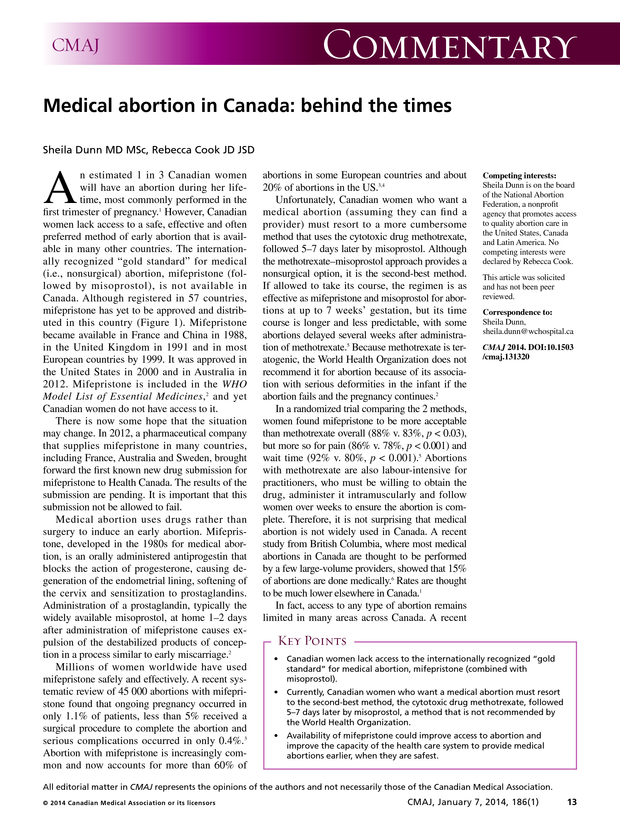http://www.cmaj.ca/site/earlyreleases/20nov14_abortion-access-grim-in-English-Canada.xhtml 4600


Outside Quebec, it can be a long road from confirming an unwanted pregnancy to accessing the means to end it.
Bloggers note: The only Grim thing here is 100,000 plus abortions and suffering Mom s with dead babies Canadian Medical Association Journal SHAME on our doctors... CMA members come to grips of yourselves and offer real choices, Women are owed More than abortion.
November 20, 2014
Lauren Vogel, cmaj
Canadian women seeking to end unwanted pregnancies face wide gaps in access to abortion and have little choice in the technique
used, a landmark study reveals.
Access to abortion
depends largely on where you live, with wide disparities among provinces
and between rural and urban locations,
according to a new survey of abortion
services in Canada. And with few options for drug-induced abortion — the
preferred method
for ending a pregnancy during the first
trimester in the United States and many European peer nations — 96% of
abortions in
Canada are done surgically.
Researchers presented
initial results of the 2012 survey, which was funded by the Society of
Family Planning, at the Family
Medicine Forum in Quebec City on Nov. 12.
The venue was germane; the study shows that 46 of Canada's 94 abortion
facilities
are located in Quebec. The province is
also a leader in equitable access; half of its abortion facilities are
in rural areas
and there's at least one facility in every
health region.
No other province comes
close to providing the same level of access. British Columbia has
16 facilities located in hospitals,
community health centers and doctor's
offices; half of these are in rural areas. There are 16 facilities in
Ontario, eight
among Alberta, Saskatchewan and Manitoba,
four in Atlantic Canada and four in the territories. Of these
facilities, only those
in the territories and one in Atlantic
Canada are located in rural areas. There is no facility in Prince Edward
Island.
The results paint a
starker picture than researchers expected, says co-investigator
Dr. Edith Guilbert, a senior medical advisor
at the National Institute of Public Health
of Quebec. "We knew about PEI and we knew that access was difficult in
New Brunswick,
but now we have real data showing that
it's not just an Atlantic matter — the number of providers in the other
English-speaking
provinces is quite low."
It's also the first clear
evidence that a laissez-faire approach to abortion provision doesn't
ensure equitable access. Since
the 1970s, Quebec has dedicated funds to
establish abortion clinics in underserved areas. And in the 1990s, BC
legislated
which hospitals must offer abortion
services to ensure rural and remote access. Both provinces support
provider networks,
and in BC there's a hotline women can call
to connect with the nearest facility in the network.
"These are the only
jurisdictions where the proportion of rural facilities is equal to or
greater than the proportion of women
living in these areas," says
co-investigator Dr. Wendy Norman, who holds the Canadian Institutes of
Health Research/Public
Health Agency of Canada chair in applied
public health research. "There are no other provincial or territorial
policies supporting
this kind of access to abortion in other
regions of Canada."
For women, this means
waiting longer and travelling farther for basic reproductive care, which
in turn puts them at higher
risk of having a second trimester abortion
and its associated complications. And for those without the resources
or time to
navigate the system, it may mean carrying
an unwanted pregnancy to term.
"Canada has never counted
the costs being incurred … when abortion services aren't accessible,"
says Norman. "You're looking
at things like the productivity of the
mother in society, and the ability of the mother to launch the children
she may already
have."
Guilbert says that
increasing access to medical abortion — that is, abortion induced by
oral medication — could close some
of the gaps in rural access because a
local family doctor could administer the drug. "It saves women having to
travel. It
saves them having to undergo a surgical
procedure."
Yet barely 4% of
abortions in Canada are done this way, compared to more than half in
some peer nations, such as France. This
is largely because the best abortion drugs
are not available in Canada — "we are relying on medications that are
not optimal,"
says Guilbert.
Health Canada has been considering whether to approve mifepristone (known as RU-486) since December 2012. According to a recent CMAJ commentary
(( article below)) (2013;186:13-14), the drug is considered the gold standard for inducing
safe and early non-surgical abortion. Instead, Canadian
physicians rely on less effective
medicines ordinarily used to treat ectopic pregnancy, or in some cases,
cancer.
"These are slow to act, and when you explain to women it's going to take two or three weeks or more before the abortion is
complete, they very quickly opt for a surgical abortion," says Guilbert.
Norman argues that's far from a choice. "We have some excellent policy and service delivery models, but currently we're not
providing top-notch access for women to the full range of reproductive services across Canada."

No comments:
Post a Comment